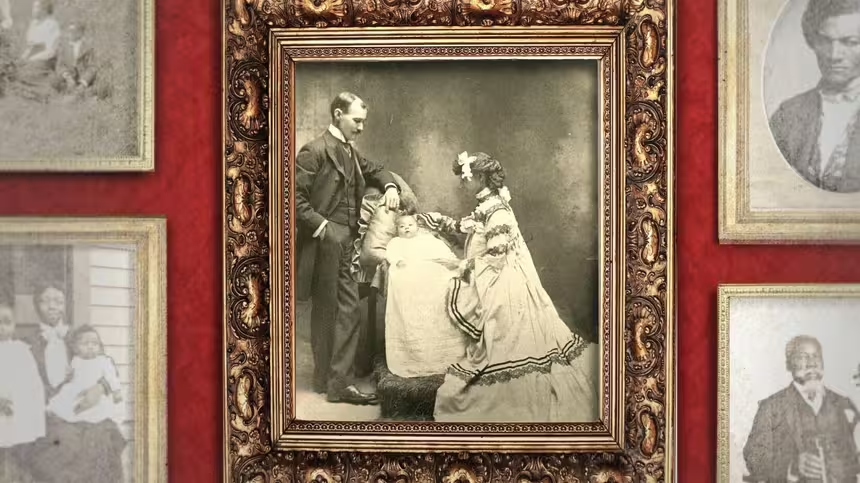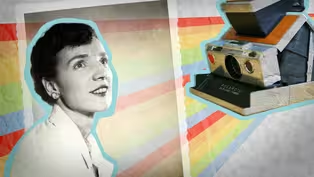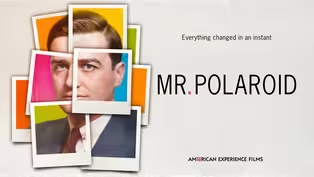
Chapter 1 | Mr. Polaroid
Preview: Season 37 Episode 3 | 9m 18sVideo has Closed Captions
Watch a preview of Mr. Polaroid.
Watch a preview of Mr. Polaroid.
Problems playing video? | Closed Captioning Feedback
Problems playing video? | Closed Captioning Feedback
Corporate sponsorship for American Experience is provided by Liberty Mutual Insurance and Carlisle Companies. Major funding by the Alfred P. Sloan Foundation.

Chapter 1 | Mr. Polaroid
Preview: Season 37 Episode 3 | 9m 18sVideo has Closed Captions
Watch a preview of Mr. Polaroid.
Problems playing video? | Closed Captioning Feedback
How to Watch American Experience
American Experience is available to stream on pbs.org and the free PBS App, available on iPhone, Apple TV, Android TV, Android smartphones, Amazon Fire TV, Amazon Fire Tablet, Roku, Samsung Smart TV, and Vizio.
Buy Now

When is a photo an act of resistance?
For families that just decades earlier were torn apart by chattel slavery, being photographed together was proof of their resilience.Providing Support for PBS.org
Learn Moreabout PBS online sponsorship♪ ♪ (seagulls squawking, waves lapping) (people calling and talking in background) NARRATOR: Miami, Florida, 1972.
The cars, fabulous.
The Dolphins, undefeated.
The Democratic and Republican conventions had come to town.
But the biggest game around was a product launch party, and the thing up for sale was a camera.
RHIANNON ADAM: This tiny little pocket-sized camera which folded up, and this perfect image that came out, the perfection of that system and how that made photography accessible and portable-- that is groundbreaking.
(shutter clicks, flash bursts, camera whirs) NARRATOR: The SX-70 instant camera was unlike anything anyone had ever seen, and it was every inch the kind of revolutionary device that Polaroid was already famous for.
I can't imagine a world without the Polaroid.
AINISSA RAMIREZ: Many of my early milestones in my life were taken with a Polaroid camera.
First Communion, loss of a first tooth, all are in that white frame.
CHRIS BONANOS: Polaroid at its peak was enabling people to make about a billion pictures a year.
No one didn't know what a Polaroid photograph was.
It's one of the most instantly recognizable brands ever.
That sense of playfulness was really at the kind of heart of the brand.
NARRATOR: Behind the magic was the genius of a man named Edwin Land, an inventor who'd been chasing the dream of instant photography since way back in the 1940s.
Land is an icon, in his time and today.
He grasped the way that we take pictures now.
Take a wallet out of my pocket and perhaps open the wallet, press a button, close the wallet, and have the picture.
Steve Jobs would tell you that Land was his idol in many, many ways, because he created this technology company that made products that people didn't even know they wanted.
LAND: A camera which you would use not on the occasion of parties only or of trips only, but a camera that you would use as often as your pencil or your eyeglasses.
PARKER SARGENT: That Polaroid camera helped expand our knowledge of ourselves, knowledge of our community, and also what we can become.
NARRATOR: Never before had anything so completely incarnated the idea that a single machine really could change the world.
For years, Land seemed able to divine what people wanted.
It was a unique, intoxicating position of power.
And making the impossible possible?
That was better than any drug on the planet.
RON FIERSTEIN: He was a bit of an egotist.
You might even say a narcissist.
This person who has been almost hero-worshipped suddenly feels that the brand is him and he is the brand.
That it cannot, somehow, exist without him.
SARGENT: For him, the Polaroid camera is something that society needs and he must deliver.
LAND: Every significant invention must come to a world that is not prepared for it.
SARGENT: And so failure for someone like Edwin Land must seem like death.
(crickets chirping, owls hooting) ♪ ♪ ♪ ♪ NARRATOR: Late one summer night in Connecticut, on a back road in the deep dark, two vehicles were speeding towards disaster.
♪ ♪ The glare from the headlights was so blinding, there was barely time to swerve.
(tires screeching) A crash would have been fatal.
But in one car, one passenger was more interested in the physics of what had just transpired than the danger.
His name was Edwin Land, and he was 14 years old.
♪ ♪ BONANOS: Edwin Land was born in Connecticut in 1909.
He didn't come from a family of intellectuals.
His father was a scrap metal dealer.
Land, though, was, you know, the classic image of the, like, overachieving brainy kid.
You're talking about the World War I era.
Obviously, there were no computers and there were no TV screens.
Entertainment really consisted of things like the kaleidoscope.
And he used to love those things.
He became fascinated with optics, and this is as a very young boy.
NARRATOR: By the time he was a senior in high school, his science teacher confessed that he had nothing left to teach him.
So, at the age of 17, Land enrolled at Harvard-- only to drop out after a single semester.
(chuckling): He's bored with Harvard.
He's bored with school.
He's bored with the normal physics courses.
He wasn't shy of doing things in an unorthodox manner.
And dropping out of Harvard, I mean, that seems like, like such a crazy thing to do.
NARRATOR: In 1927, Land moved to New York City, where he hoped to develop a filter to solve the problem of headlight glare.
And whenever the young inventor needed help, he enlisted his girlfriend, Terre Maislen.
Late at night, the pair would sneak into the physics laboratory at Columbia University to conduct experiments with different glare-reducing materials.
Land described it as a "transient, violent need to create."
The urge was so strong, he explained, "you have a feeling of almost divine guidance."
The solution to the glare problem on America's roads, Land now believed, lay in a physics phenomenon known as polarization.
I will preface this by saying this is a very coarse approximation of the science, but: light rays coming at you are actually quite scattered.
NEWSCASTER: It is evident that water waves have an up and down motion, as well as a direction of travel.
And so it is with light waves.
BONANOS: A polarizing filter, it has, at the microscopic level, slats.
Some light comes in, some light doesn't come in.
You have one polarizing filter.
You see, you can see through it.
Second one goes behind it, doesn't change the color much.
Turn it 90 degrees, and it goes to black.
NEWSCASTER: It was not until the invention of a synthetic polarizing material by the scientist Edwin H. Land that polarized light could be put to work outside the laboratory.
NARRATOR: By 1932, Land had founded his own lab in Cambridge, Massachusetts, to refine the manufacturing of thin plastic polarized sheets.
Just five years later, it had become a proper company-- Polaroid.
Land's new polarizing film worked perfectly to reduce headlight glare, but, as it turned out, Detroit would never go for it.
RAMIREZ: The automotive industry decided that too much work was required in order to put special films on the headlights and then also retrofit all the other automobiles, so they weren't really interested.
BONANOS (chuckles): It was a great idea, and still has not been... (laughing): ...been, been worked out 80 years later.
NARRATOR: Land was undeterred.
He had already dreamed up other uses for his plastic polarizers.
FILM NARRATOR: Polaroid light control materials will affect the lives of increasing millions in the new world ahead.
FIERSTEIN: He used it to make Polaroid sunglasses.
Camera lenses.
RAMIREZ: He made the polarizing films that went into 3D glasses, special desk lamps that didn't have glare.
BONANOS: In the 1930s, Polaroid got licensed to make a window for a railcar.
(train whistle blows) FILM NARRATOR: If the sun is directly on you, you can rotate the inner window pane and cut down the incoming light.
RAMIREZ: So Land is looking at every way that he can use this product.
The war starts.
(engine roaring) The armies and the military are trying to find every advantage that they can have.
And one of them is to block light.
BONANOS: Very quickly became clear during the Second World War that using polarizing filters could make gunsights and bombsights and goggles for pilots.
The war effort was a big boost to Polaroid.
The company grew like crazy during the war.
FIERSTEIN: But Land could see that the war was not going to last forever.
BONANOS: And he knew that when those contracts came to an end, that he was going to have to shrink way down again.
And he didn't like that idea.
So he was trying to figure out, you know, "What's the future going to be for my company?"
Said, "We're going to have to do something else."
And he was sort of fishing for what that other thing was.
Why do people shake Polaroid pictures?
Video has Closed Captions
Clip: S37 Ep3 | 1m 58s | We were told to "shake it like a Polaroid picture". But what if we got it wrong? (1m 58s)
Video has Closed Captions
Clip: S37 Ep3 | 3m 8s | The women behind the camera. (3m 8s)
Video has Closed Captions
Preview: S37 Ep3 | 1m 45s | The story of Edwin Land, whose iconic Polaroid camera let everyone instantly chronicle their lives. (1m 45s)
Providing Support for PBS.org
Learn Moreabout PBS online sponsorshipSupport for PBS provided by:
Corporate sponsorship for American Experience is provided by Liberty Mutual Insurance and Carlisle Companies. Major funding by the Alfred P. Sloan Foundation.




















